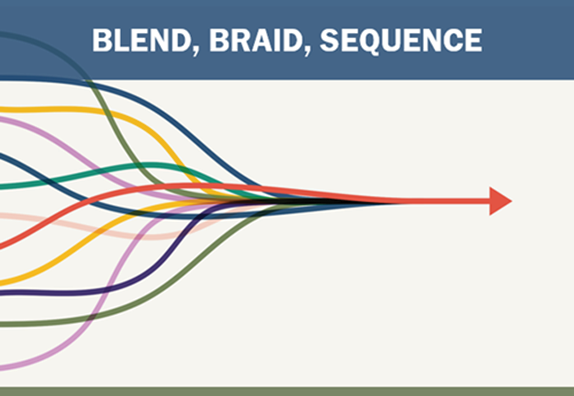
The Value of Leveraging Across Multiple Systems
Resource leveraging and service coordination across various public systems can increase competitive integrated employment (CIE) for workers with disabilities. Through collaborative efforts, state and local entities that provide employment support services can maximize employment, inclusion and economic advancement outcomes for disabled people.
Blending, braiding and sequencing (BBS) are innovative strategies that maximize the efficient and effective use of federal funds across systems to help people with disabilities secure and maintain CIE.
Defining BBS

Blending occurs when dollars from multiple funding streams combine to create a single “pot” of commingled dollars which can fund an initiative or purchase more specific services. Blending involves pooling funds from multiple sources to support a common goal, such that each individual funding source gives up its program identity.
Typically, states or regions need explicit authorization by statute or regulation to allow the blending of funds. However, Ticket to Work Outcome and Milestone payments do not require separate tracking and can be blended with other fund sources that do not require tracking, based on program authorization.

Braiding occurs when multiple funding streams separately and simultaneously provide specific services. Because braiding involves simultaneous service delivery by two or more systems, it may require interagency coordination and collaboration with this specific goal in mind.
For instance, the Centers for Medicare & Medicaid Service (CMS) has clarified that Ticket to Work Outcome and Milestone payments funded through the Social Security Administration may occur simultaneously with payment for Supported Employment services funded through the Medicaid Waiver program to create a more robust support system for individuals seeking sustained CIE.

Sequencing occurs when multiple funding streams separately and sequentially provide specific services.
For instance, an individual may begin the journey toward sustained CIE through funding available under the Individuals with Disabilities Education Act (IDEA). When they age out of educational services, they may continue with funding through vocational rehabilitation (VR) and progress to Medicaid funding through a Home and Community- Based Services (HCBS) waiver for sustained job coaching over an extended period of time.
Increasing Blending, Braiding and Sequencing within Federal, State and Local Systems
Resource Leveraging & Service Coordination to Increase CIE for Individuals with Disabilities – ODEP and DOL’s Employment and Training Administration (ETA) joined seven other federal agencies in a joint communication that encourages state and local governments throughout the nation to BBS funding to proactively maximize resources and improve CIE outcomes for disabled youth and adults. The joint communication also includes a set of frequently asked questions on leveraging resources.
Improving Transition Services for Youth and Young Adults with Disabilities through Braided Funding – Federal initiatives fund key transition and employment supports for disabled youth and young adults. This brief discusses how service providers can leverage these different resources, maximize efficiency of delivery and strengthen programs through braided funding.
Training Employment Notice 07-22 – This document encourages state and local partners to implement BBS strategies across systems to maximize resources and increase CIE for youth and adults with disabilities.
Blending, Braiding and Sequencing in Practice
Yes, WIOA Can! Effectively Leveraging or Braiding Multiple Funding Sources with WIOA – This webinar serves as technical assistance for WIOA grantees to understand how to braid multiple funding sources to achieve improved outcomes. Presenters share how WIOA funds can be leveraged or braided with other funding streams and how to properly track funds. The webinar also showcases examples of local areas that have braided funds.
How Blended, Braided or Sequenced Funding Can Help Drive Employment, Equity and Inclusion – Hosted by the ODEP funded National Center on Leadership for the Employment and Economic Advancement of People with Disabilities (LEAD Center), this federal interagency webinar features state and local practitioners from across Arizona, Colorado and North Carolina workforce systems that support people with disabilities. Presenters discuss how they successfully apply innovative, collaborative resource-sharing to benefit both businesses and job seekers with disabilities.
In-Depth Q&A Event: Blended, Braided and Sequenced Funding for Employment, Equity and Inclusion – This LEAD Center Q&A event features professionals from Arizona, Colorado, Maryland, North Carolina and multiple federal agencies who answer implementation and policy questions related to BBS.
Celebrating Olmstead: How Blending, Braiding and Sequencing Leads to Integrated Employment – In this federal interagency webinar, hosted by the LEAD Center, Maryland practitioners share their promising practices at the state and local levels, including lessons learned and tools used to sustain partnerships.
On the Ground Success
- Colorado braiding and sequencing of services
- North Carolina sequencing
- Anne Arundel Workforce Development Corporation braids and blends resources to better assist individuals enrolled in their workforce employment network
- Wisconsin’s braided funding efforts
Additional Resources
- A Framework for Community Engagement – A Pathway to CIE – This brief for policymakers and service providers, developed by the U.S. Department of Education’s Office of Special Education and Rehabilitative Services, in partnership with ODEP and the Department of Health and Human Services’ Administration for Community Living and Substance Abuse and Mental Health Services Administration, explains the meaning and benefits of community engagement.
- Value-Based Payment Methodologies to Advance CIE: A Mix of Inspiring Examples from Across the Country – Developed by Medicaid expert Dr. Lisa Mills, this guide provides examples of best practices as states determine their Medicaid service rates. The guide shares strategies states used to enact rates that incentivize services that lead to CIE. Along with the guide, ODEP hosted a three-part webinar series highlighting key components from the guide.
- Value, Outcome and Performance-Based Payment Methodologies to Advance CIE in State Medicaid Long-Term Services and Supports (LTSS) Systems and Managed Care LTSS Systems – This webinar discusses a range of examples from state Medicaid LTSS systems – including those who do and do not use managed care – that have designed and implemented value-based purchasing and outcome-based reimbursement methodologies specifically intended to advance their Employment First and CIE efforts.
- Supporting Employment Service Providers to Succeed and Prosper by Partnering to Advance CIE: Applying Value, Outcome and Performance-Based Payment Methodologies – In this webinar hear from employment service providers (ESP) that work with state VR systems and state Medicaid LTSS systems. Some of the ESP presenters have used managed care and others have not. All discuss how they have implemented value-based purchasing and outcome-based reimbursement methodologies so that ESPs can prosper as they advance CIE.
- Advancing CIE: Value, Outcome and Performance-Based Payment Methodologies in State VR and Behavioral Health Systems – In this webinar, state administrators discuss a range of value-based purchasing and outcome-based reimbursement methodologies, practices and structures in state VR and behavioral health systems specifically intended to advance evidence-based practices, CIE outcomes, policy alignment and rate alignment and restructuring.
- Guide for Creating Successful CIE Memorandums of Understanding (MOU's) – This guide provides a step-by-step process that walks agencies through MOU development by illustrating who should be at the table, key areas to include in an MOU, strategies for completing the MOU and tips for proper implementation.
